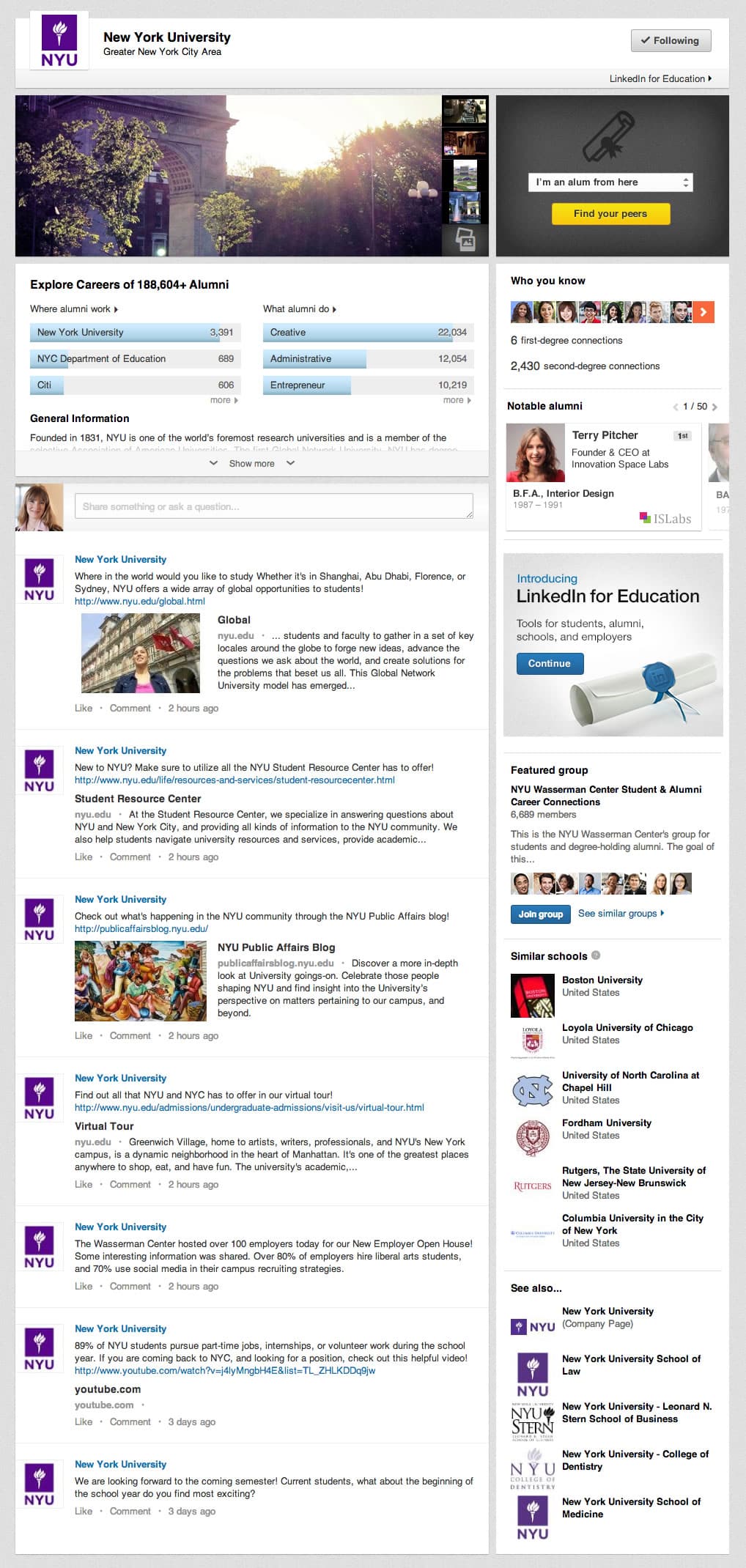LinkedIn instantly gets more relevant with launch of University Pages
Over the last few months we have written extensively about the increasing demand for higher education institutions to link their programming to industry and to prove that their degrees result in post-graduate success. Now, LinkedIn – “The World’s Largest Social Network” – is leveraging this demand by introducing University Pages and by updating its Terms of Service to allow users as young as 13 on the site (age requirements vary by country). The change in access kicks in as of tomorrow, 12 September. University Pages was launched in late August and currently a little more than 200 universities, most in the US, have been invited to set up their pages. LinkedIn plans to extend this to thousands once it has tested the new service among the current universities that have set up pages. University Pages allow students to:
- Access campus news and activities, ask questions of the school, engage with current students and alumni;
- Research the careers of graduates of various universities and see which have produced notable alumni;
- Network post-graduation with classmates for professional purposes.
The following screen capture is an example of a University Page for New York University:

- Images and video, which can reinforce your higher ed institution branding or showcase your uniqueness;
- Updates and news;
- Basic descriptive and contact information;
- Detailed information such as institution type, year level, financial aid, tuition, degrees, fields of study, population, student/faculty ratio, % admitted, male/female ratio, % receiving aid, graduation rate;
- Notable alumni;
- A "Featured group" containing information on a specific university-affiliated group (e.g., an alumni group);
- A "See also" section where institutions can add their normal LinkedIn company page.
A section in the right-hand column will also show “Similar Schools” – important since often students consider an entire competitive set when choosing schools.
Lots of potential for recruiters
Hubspot has a great post on the potential power of LinkedIn University Pages. Perhaps the most important point Hubspot makes of the new service is that it:
“ … aggregates, from LinkedIn’s 225 million members, information about your alumni base, including where alumni live and work, what industry they're in, what they studied, and their specific skills. This allows prospective students looking at your University Page to determine if the skills they're looking to develop or the industry they’re interested in aligns with what your university offers. It also highlights what your university is known for in terms of academic preference and performance.”
This is a lot more interesting to prospective students than the “push” marketing they often get (e.g., brochures) that can’t as dynamically make a link between an institution and the success of its graduates. The other crucial point Hubspot makes is that the new ability of younger students to be on LinkedIn University Pages makes it more possible to establish a relationship with students when they are in high school, just beginning to think about what universities they will consider and actively looking for indicators of reputation, alumni networks, and return on investment. Hubspot mentions a host of other ways in which eligible universities can leverage LinkedIn’s University Pages, including:
- Providing more specific and detailed information to students who indicate particular interests;
- Providing such information in exchange for emails and other contact information;
- Encouraging current students to act as brand advocates on the pages (e.g., via testimonials);
- Reconnecting with alumni to have them support the brand as well (e.g., by sharing their experiences with prospective students);
- Creating parents-only pages to nurture this important target audience.
University Pages part of LinkedIn’s younger demographics
University Pages makes a lot of sense viewed in light of the fact that there are over 30 million students and recent college graduates on LinkedIn; the company says “they are LinkedIn's fastest-growing demographic.” “Currently, if you have a company page for your college, you can share updates. University Pages will enable you to target your messages to different groups that are part of your community, alumni, and current students,” notes Higher Education Marketing. “You will also be able to create a custom target audience by categories such as location, education, industry, company, and even more.” It's important to understand that University Pages are not a replacement of the current company pages that universities and colleges use. Rather, on University Pages schools can connect with their alumni, students, parents or prospects, answer questions, and engage their audience. Company pages, on the other hand, are the place to position your school as an employer. While University Pages is currently available to a relatively small number of universities, your higher education institution may well have the opportunity to be on it soon, if it is not already. If your institution doesn’t yet have a University Page on LinkedIn, you can request one if you have a university email address associated with your LinkedIn account. You will also need to show that you are a current employee of the institution by noting your position there in the Experience section on your LinkedIn profile. With those basics in place, you can then contact LinkedIn to request your page. In preparation, now is a great time to make sure your institution is optimising its company page on LinkedIn. LinkedIn has an excellent slideshow to help you do just that:
Jessica Winters, owner of jLink Marketing and Coordinator Marketing & Social Media at the University of Groningen in the Netherlands sums up how to view social media platform management like this:
“Facebook is personal and informal, LinkedIn is corporate and professional, Twitter is fast and more ‘newsy,’ and Pinterest is all about beauty and design. To make social media work, use each network for what it is intended.”
“Think of this as a tug-of-war for teens’ attention,” advises Forbes. “Fun-seeking adolescents will stick with Facebook’s gossip friendly format. Meanwhile, their most ambitious classmates will be drawn to LinkedIn’s newest treat: bar charts full of information about the career paths of alumni from hundreds of brand-name colleges.”
Whatever the differences between the platforms, there is always one commonality that distinguishes good social media practice from bad: offering value to a well-researched and listened-to audience. When your institution posts on LinkedIn – including the stories and articles it shares to followers – always make sure it serves your audience while reinforcing the institutional brand.
More tips on optimising LinkedIn company pages coming soon – stay tuned! For now, a LinkedIn infographic showing the platform’s global reach at the start of this year (numbers have since risen):













